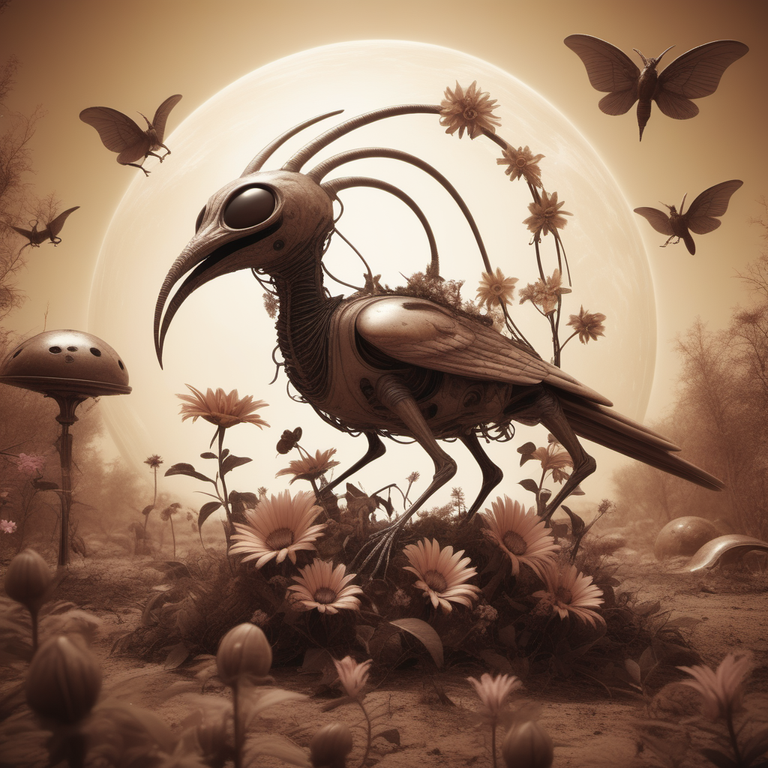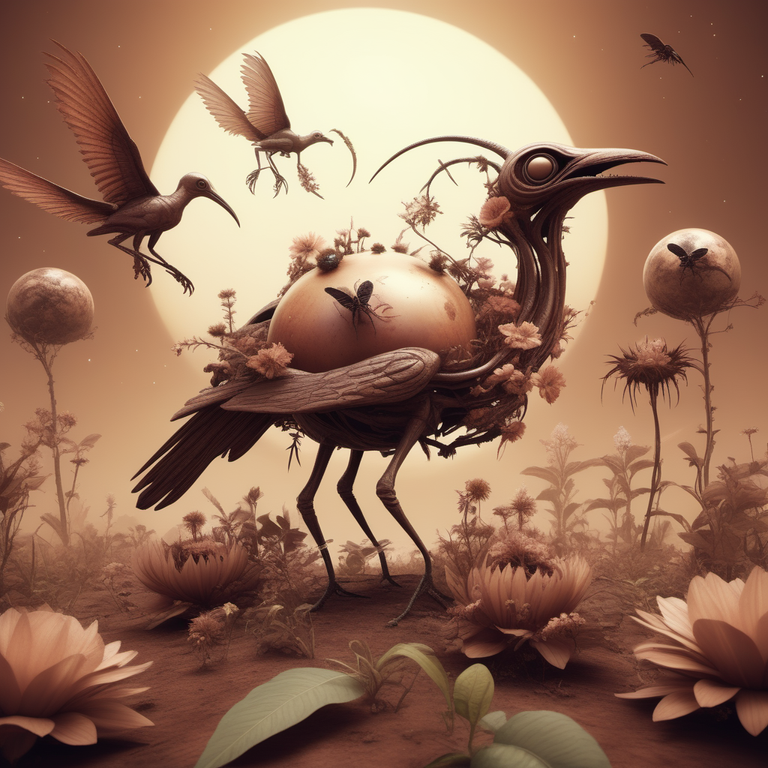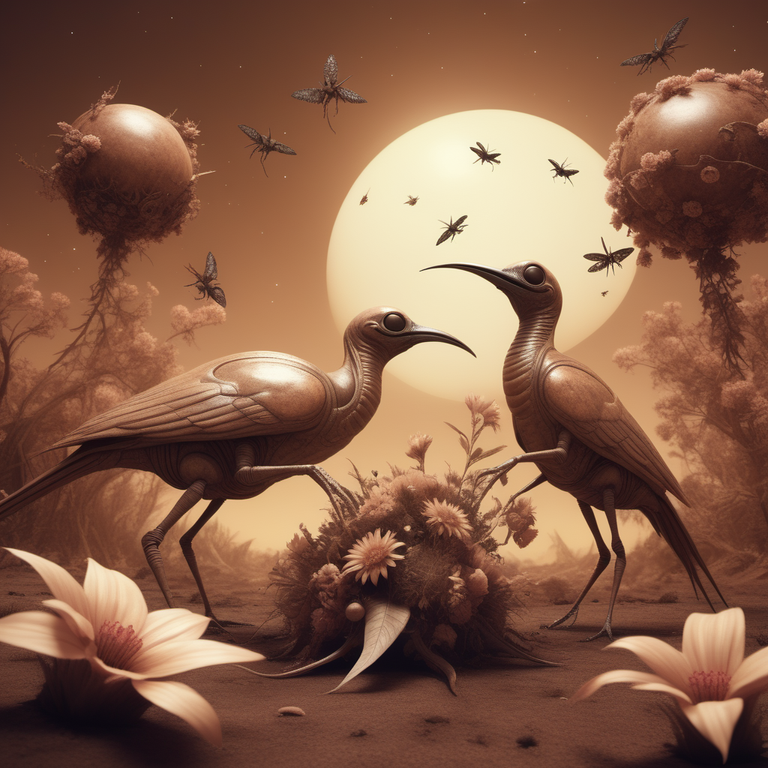Signal Theory
The loud call of the quorka wakes me up. It is a really terrible sound with screeches, yelps, and machine-gun pops. The signals change throughout the year. They are complex, and the birds use them to communicate different types of information.

I sit up in bed and through the domed window, I see the jungle canopy stretching on for miles until it disappears in the haze. On the sky, I see distant Jupiter floating like a ghost near the biomoon’s horizon.
There is a knock on the door.
“Good morning, Dr. Fields.”
Joan, my assistant, peeks from behind the door.
“Good morning, Joan.”
“Breakfast will be ready in fifteen minutes.”
“Thank you, Joan. Please add a glass of gavia juice and level three antixodants.”
“As you wish, Dr. Fields.”
The new research crew won’t arrive until two months from now, so for the next five Jovian months, it’s only Joan and me in this quadrant of the research zone. She was assigned to me as a new “research assistant” model, which meant she required some training. I wasn’t too thrilled with the prospect of babysitting an android. They possess a keen computational intelligence but can be unpredictable if left to their own devices. At least the new models are fast learners and require less supervision, so her training has been seamless so far.
I check the research schedule and see that I need to trek down to the lake for some water samples. I’ll need my rifle to scare off the quorkas if they come too close. They’re not poisonous, but their bite can be nasty. I'm not too worried about Joan, who is built of military-grade technology with several self-defense mechanisms. I ask her to prepare for the hike.
After breakfast, Joan and I make our way through a path that cuts along the western sector towards the lake. The morning feels muggy and oppressive with a dirty yellow mist hanging in the air. I can’t wait to see what the new environmental systems will do to this place once they're installed. I’m not too enamored of the surroundings, as scientifically stimulating as they are.
As we enter a particularly dense area, we hear the piercing calls of the quorkas in the bush. We stop and listen. I instruct Joan to start recording. The birds sound particularly excited about something. I should really be on my way to the lake, but what kind of endo-biologist would I be if I didn’t investigate?
I ask Joan to sneak through the smaller spaces and head towards the sound. She does so with ease and stealth. On my lenses, I can see a live feed of what she sees in the thicket.
Parting aside the broad leaves, she spots a group of quorkas feasting on tyrol eggs.

The tyrol carry large eggs on their back for a certain period, after which they place them on the ground. When left unattended, the eggs provide a nutritious bonanza for the quorkas, whose loud calls echo through the jungle and travels for miles around.

“Focus on the ones making the calls,” I say to Joan.
She turns her head and shows various quorkas off to the side thrusting their long beaks up and down as they make the shrill sounds. This must require a lot of energy, and it will probably attract predators or competitors, so why go through the trouble? Wouldn’t it be more advantageous to eat in silence? There must be a value to it, otherwise, the behavior wouldn’t exist. For all the artificial biology added to this moon, Darwinian rules are still in play.
“Perhaps,” I say to Joan later at the lake, “they yell because the egg shell is too tough, and they need to attract a larger predator to open the egg. They will lose some of the food, but they can at least enjoy the scraps.”
Joan wades across the water towards the shore with the samples in her hands. Her smooth silver body glows in the dim sepia light.
“Would you like me to run a study to test the hypothesis?” She says.
“Yes, let’s do that. The tyrols are productive right now, so let’s take a few random egg samples for the stimuli.”

In the next few days, Joan and I design and implement a study to see if the call-a-larger-predator-to-open-the-eggs hypothesis pans out. The design is not as thorough as I like them to be, but given the time constraints, there’s no choice.
I usually prefer doing on my own data collection, but this time Joan will be in charge. As an android, she’s the only one equipped to navigate deeper into the toxic jungle.
After a couple of weeks of collection, a pattern becomes clear in the data. The quorkas call out regardless of whether the egg is cracked or not. Sometimes, even if the eggs are still whole, they do not call at all. So, no, they are not trying to attract larger predators to open the tough eggs. The hypothesis has been refuted.
“Perhaps, they’re calling others to dilute the risk of being predated themselves?” says Joan.
“You mean, they’re willing to throw their friends to the dogs?”
“An antiquated sentiment, but yes, in a manner of speaking that is the essence of the argument.”
“If that’s the case,” I say adjusting the guesses on the design pad, “then there should be an optimal size of quorkas in a given egg patch. More than a certain size and calling more birds becomes detrimental to the original birds who would have to share the bounty. So, we predict that once a critical number of birds at an egg site has been reached, they should stop calling.”
“Would you like me to proceed with the preparations for the test, Dr. Fields?” says Joan.
“Please do so.”
She takes a couple of days to gather and place the eggs in the assigned spots where we have installed the recording instrumentation. Joan is methodical in her approach as she quietly moves through the thick vegetation. When she communicates with me, she does so in a very professional and technical manner. Strictly detached and scientific. I appreciate that but sometimes wonder how she knows what I prefer.
After a few days worth of data, I could see no relationship between the number of birds in an egg patch and the calling behavior.
“So much for the throw-your-mate-to-the-dogs hypothesis,” I mutter.
“Would you like me to continue gathering data, Dr. Fields?”
“For the sake of thoroughness, let’s continue for three more days,” I say. “Then we’ll think of something and implement it. Hopefully, we’ll have enough eggs this late in the season.”
As the end of my stay in this station approaches, I busy myself with preparations for my departure and the arrival of the next team. I can’t say I’m going to miss this quadrant. I’m very much looking forward to spending some time on the beaches of New Galapagos, doing nothing but admiring the grand views of a pure blue sky.

“Dr. Fields? Are you awake?”
I rub my eyes. “I am now.”
“I am sorry to wake you up so early, but I just wanted to give you a report.”
“A report?”
“Time is of essence, Patrick.”
Patrick?
I sit up in bed and summon a display.
A shrill cacophony pierces the air.
The shapes of quorkas appear on the stream. On trees, on the broken egg shells, and on Joan!
“Joan, where are you? Get out of there!”
“I cannot, I’m afraid. I'm trapped. I don’t have much time. So please listen to me. I have solved the mystery of their calls.”
The birds peck at her limbs and make a dull sound as they strike her dermal shell.
"Tell me where you are!"
"Please listen! Otherwise, it would all have been for nothing," she says, her voice rising with human-like emotion. “When the quorkas pair up, they defend their territory fiercely from intruders.”
The camera trembles as the birds peck at her face.
“But what if the number of intruders is large?" she continues in spite of the attack. "They would overwhelm the residents with their superior numbers. So, we can hypothesize that the residents, who own the territory, will not emit calls when they find eggs, while the opposite would be true of non-residents.”
She shows me a 3D bar chart illustrating the number of birds on the horizontal axis, and on the vertical, the number of visiting days to the egg patches.
"See? when there is only one resident or a pair, they visit the patch often and remain silent while feasting. But when non-residents find the eggs, they emit loud calls that are heard by others outside the territory, soon their numbers grow and you only find a large group on the patch. That why you only see these two major groupings in the results."
A quorka jumps on her chest.
The camera stream from her right eye goes dark.
I grab my rifle and rush out the door.

I follow the sound of the calls and find a large group of quorkas in the eastern sector. I fire the rifle to show them I mean business.
They scurry off into the bushes.
Joan’s body lies scattered on the grass. I gather the pieces in silence. When I find her upper torso and see the electronics spilling on the side of her broken face- I feel a knot on my throat.
Why should I feel this way about an android? Her backup core is intact. She can be rebuilt at the factory.
I place the broken pieces of her body in the specimen box and carry them back to the station, feeling like I've just lost something and someone special.

Discussion
This story was based on the work by Bernd Heinrich (1988), whose research focused on the behavior of ravens in the wild. Emitting a signal carries a cost to the one emitting the signal, and after observing ravens in the wild making loud calls, he decided to investigate the adaptive value of these calls. While I tried to stay faithful to the results of the research, all the characters and events in the story are fictitious.
In the story, I assume that similar behavior may be exhibited by synthetic (human-made) species, if left to evolve in their own environment. It also has implications for any alien species we may encounter in the far future.
Resources
Heinrich, B. 1988. Winter foraging at carcasses by three sympatric corvids, with emphasis on recruitment by the raven, Corvus corax, Behavioral Ecology and Sociobiology 23:141-156

Images generated by @litguru using Stable Diffusion software
What a terrific story, @litguru. It's so good to see you in The Ink Well again!
I love how you add details and build the world for your story in subtle ways. There was so much information packed into these few sentences, for example:
Thanks for sharing the inspiration for the story. Very cool. We have very few sci-fi writers in The Ink Well. I hope you will inspire others!
Hi @jayna! I finally got my lazy butt to write some proper short fiction :)
I enjoy interpreting the research from animal behaviorists, though I feel their own accounts are infinitely more interesting because they're real. This particular researcher had to carry around carcasses to do his research so that was probably not pleasant 🤢
I hope more authors write some science fiction. It really is fun imagining the future. 😎
The images you used to illustrate the story were so perfect for the stark and interesting life on that planet.
In this story, I developed the theme first and then generated the images when I was writing the story. Sometimes I would notice something in the illustration that triggered an idea, so I incorporated it into the story. Visualizing ideas like this makes writing much more fun!
Wow, cool technique!
Your story is so complete and satisfying, @litguru. The characters are nicely developed, the conflict (research dead ends) is interesting, and the story ending with an emotional loss of a robotic friends is very touching.
Thank you for sharing your story in The Ink Well! Please remember to read and comment on the work of at least two other community members. Thank you!
Thank you so much @theinkwell! It's Halloween season, so I was in the mood for writing something suspenseful! :D
This is simply fantastic, @litguru! You take us on an intriguing journey into an alien world with unique creatures and advanced tech. Silly me, when I started reading, I went to look up quorka in a dictionary and didn't find it. I mentally face-palmed. It's Litguru! Of course, it's sci-fi. 😂
Your world building is topnotch and places us on the scene with Joan (I love her already) and Dr Fields. I enjoyed how you subtly build the relationship between the two characters through their daily routines.
But the ending. 🥲 It's intense and emotional. Joan's sacrifice to please Fields and further his research humanizes this android. And those quorkas are mean. 😄
I need to get me one of these!
Beautifully written as always! !PIMP
You must be killin' it out here!
@kemmyb just slapped you with 1.000 PIMP, @litguru.
You earned 1.000 PIMP for the strong hand.
They're getting a workout and slapped 1/1 possible people today.
Read about some PIMP Shit or Look for the PIMP District
This is funny! The word is a play on croak, which is the sound made by ravens, who are the subjects in the original study.
I wanted to explore more about Joan's motivations. Did she learn something new? Why did she act on her own free will? Did she misunderstand his words and aims? Why didn't she defend herself against the birds? Alas, the story was getting too long.
Thank you for reading and this thoughtful comment!
These would add more depth to the narrative. I would love to know more about Joan. 🙂
This is superb and a simple goodread! Thanks for sharing.
Thank you @chrysanthemum! Much appreciated.
This is very interesting!
At first, I had no idea Joan was an android, but I started liking her even more when I found out.
It really touched me when she sacrificed herself for Dr. Fields. She's such a caring and selfless assistant.
Thanks for sharing your scientific story with us. I love how it's presented!
Thank you @phyna! I like Joan's character. I wanted to explore her motivations further but perhaps it's better if they remain a mystery. :)
Greetings, @litguru!
Your story has been selected to be part of The Ink Well's 128rd Magazine. Thank you for your presence in the community.
https://peakd.com/@theinkwell/the-ink-well-highlights-magazine-128
Thank you @gracielaacevedo! It's an honour! :)
I just read your comment to @kemmyb. It happens that I was very interested in the relationship between Joan and Fields. Although you may not have explored this aspect of the story as much as you wished, still the dynamic between the two came through.
The 'scientific method' was well demonstrated. The quorkas are believable, well defined. Your world building topnotch. But I found the subtle tension between Fields and Joan the thread that held my attention.
Fields spends a lot of time thinking about her, wondering about her. She is a cipher, but one we suspect has more depth than an android. That conundrum--when does artificial intelligence become more than a mechanical servant--has been explored many times, most memorably for me in Blade Runner.
As always, the pleasure you take in writing is evident. You explore not only to entertain others, but to exercise your own creative curiosity.
As I have said before--you are one of a kind.
Thank you, @agmoore! I enjoyed writing about these two characters. I think that as readers, we can't help but empathize with mechanical beings and ascribe agency to them. These questions about their "humanity" and how it manifests in their behavior are becoming more relevant today. It seems that in the story world, the social boundaries between the artificial and the human are clear, at least superficially. As you noted, there is a subtle tension between the two characters, even if outwardly they're very formal in how they interact with each other. I'm always thrilled to see you capture some of that nuance. I appreciate your wonderful comment! :)
Very very artistic images of the story...
So glad you liked it @jorgebgt. Thank you!
Boy am I impressed by what you've done with the resource you employed. Science isn't supposed to be interesting to non-scientists but I was glued.
At first, I assumed Dr. Fields a woman until Joan called him Patrick. 🥲
This was also educative. Well done!
PS: The images you invented are so real I imagined the story finely. 🤍
I enjoyed reading the scientific paper on which the story is based. The results shown in the story are real, but the original study was done with crows. Thank you for reading and your wonderful comment @uchelee!
Nice.
Yes, you said so, pretty cool.
You're most welcome.